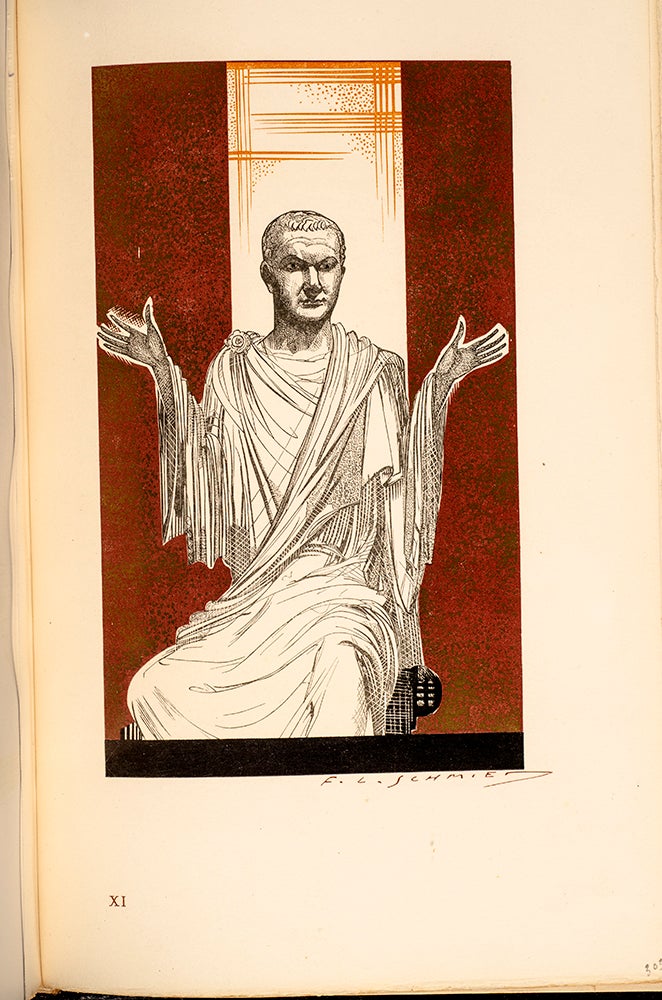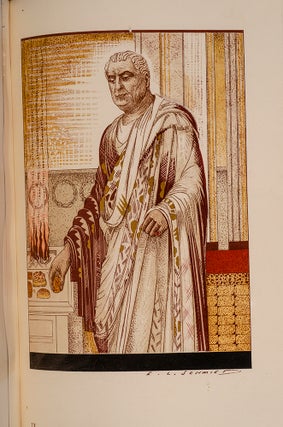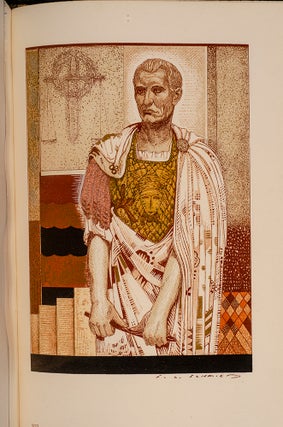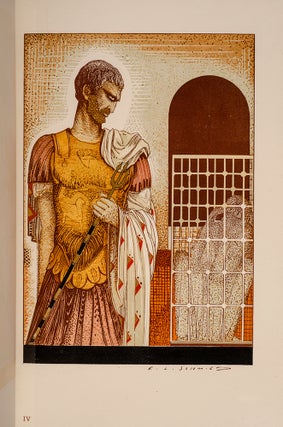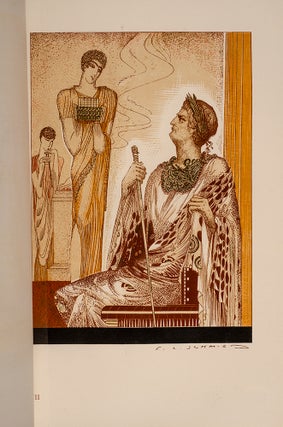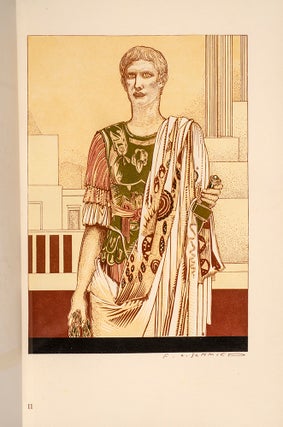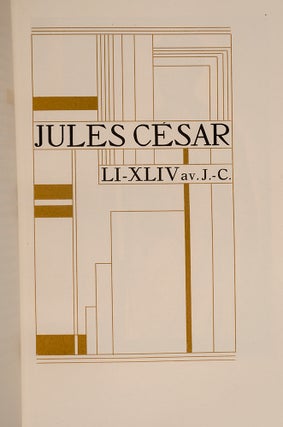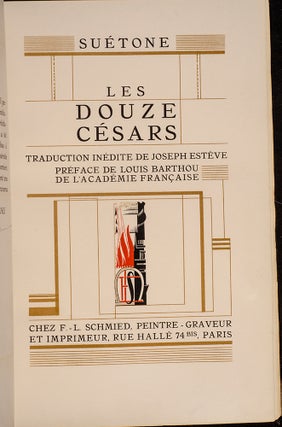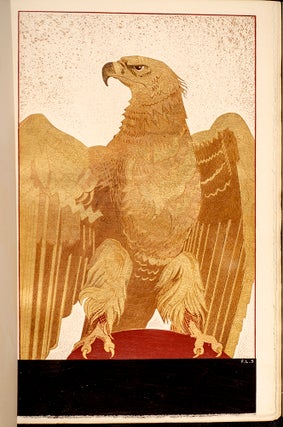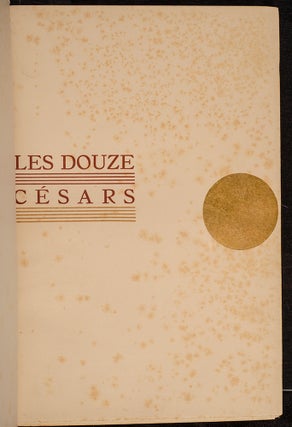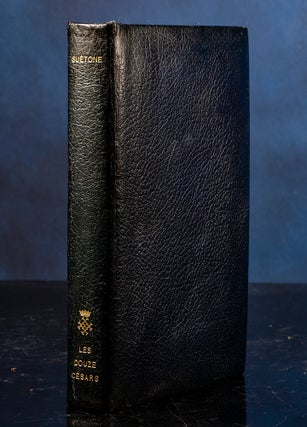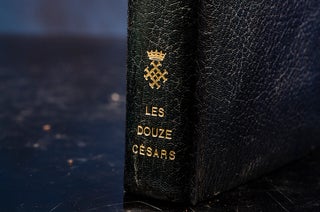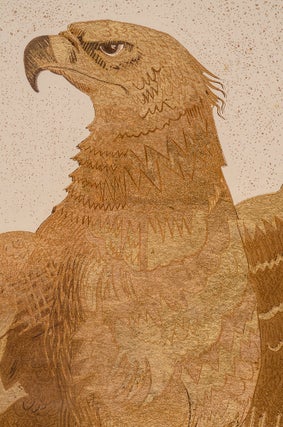Les Douze Césars
Paris: F.-L. Schmied, 1928. Item #04956
Livre D'Artiste - Francois Louis Schmied's The Twelve Caesars
SCHMIED, Francois-Louis, illustrator. Les Douze Césars. Traduction inédite de Joseph Estève. Préface de Louis Barthou de L'Académie Francaise. Paris: F.-L. Schmied, 1928.
Limited to 175 copies printed on vélin d'Arches (this being no. 165) signed by F.L. Schmied.
Large octavo (11 1/4 x 7 3/8 inches; 286 x 188 mm.). [viii], 1-[10], I-CCCXXVI, [viii] pp. Decorative title and section titles printed in gold, and twenty-three color illustrations by Schmied, comprised of nine vignette tailpieces, and fourteen full-page plates, including the twelve portraits. Small stain (5/16 x 5/16 inch) on lower margin of preface and first dedication leaf. Original printed wrappers and spine bound in, some light foxing to wrappers only. Near fine.
Bound ca. 1928 by Phillipe Gonin (stamp-signed in gilt on front doublure) in full dark blue crushed levant morocco, smooth spine lettered in gilt, medium blue calf doublures, dark blue watered silk endleaves, top edge trimmed, others uncut. Joints expertly and almost invisibly repaired.
A wonderful example of the highly appealing Schmied livre d'artiste version of Suetonius' classic biographies of the First Twelve Roman Emperors, originally written in 121 A.D.
The Plates:
Julius Caesar; Augustus; Tiberius; Caligula; Claudius; Nero; Galba; Otho; Vitellius; Vespasian; Titus & Domitian
"In addition to engraved portraits of the Caesars, Schmied decorated the book with some elaborate designs in rules, printed in gold. One hundred and seventy-five copies were printed of which the first thirty copies contained suites of the illustrations in black and in color." (Ward Ritchie. Art Deco. The Books of Francois-Louis Schmied, p.32).
Francois-Louis Schmied (1873-1941) was one of the most important, original, and active figures in the world of artists' books. He was born and studied in Geneva, moved to Paris at age 22 to make a living as a wood engraver, and joined the French Foreign Legion in his mid-40s, losing an eye in the Great War. It was after 1919 that Schmied began to focus primarily on the production of "editions de luxe," and in the mid-1920s, he and his eldest son Theo managed an atelier that issued a distinguished series of sumptuous works in very small editions, largely for members of elite French bibliophile societies. The Roman biographer Suetonius (69-after 122 AD) served for some years as a secretary to Hadrian, but he was dismissed for an indiscretion involving the emperor's wife, after which he retired from public life in order to devote himself to literature. He wrote a considerable number of biographies as well as works on antiquities, natural science, and even linguistics, but all that have survived are his "Lives of Famous Men" (in part) and the present "Lives of the Twelve Caesars." Our work contains biographies of the Roman rulers from Julius Caesar through Domitian, with formulaic descriptions of family history, public career, physical appearance, private life, and vices and virtues. The work is of great interest to us mainly because of its material relating to the emperors' often scandalous private lives, material to which Suetonius had access in the imperial archives, and material that would otherwise have been lost.
De vita Caesarum, commonly known as The Twelve Caesars, is a set of twelve biographies of Julius Caesar and the first eleven emperors of the Roman Empire written by Gaius Suetonius Tranquillus. The work, written in AD 121 during the reign of the emperor Hadrian, was the most popular work of Suetonius, at that time Hadrian's personal secretary, and is the largest among his surviving writings. It was dedicated to a friend, the Praetorian prefect Gaius Septicius Clarus. The Twelve Caesars was considered very significant in antiquity and remains a primary source on Roman history. The book discusses the significant and critical period of the Principate from the end of the Republic to the reign of Domitian; comparisons are often made with Tacitus, whose surviving works document a similar period.
Gaius Suetonius Tranquillus, commonly known as Suetonius (c. 69 – after 122 AD), was a Roman historian who wrote during the early Imperial era of the Roman Empire. His most important surviving work is a set of biographies of twelve successive Roman rulers, from Julius Caesar to Domitian, entitled De Vita Caesarum. Other works by Suetonius concern the daily life of Rome, politics, oratory, and the lives of famous writers, including poets, historians, and grammarians. A few of these books have partially survived, but many have been lost.
Ritchie, 26.
Price: $3,500.00

 I have been in the rare and antiquarian book business for over forty years; my family has been in the rare books business since 1876. Rare books are in my blood.
I have been in the rare and antiquarian book business for over forty years; my family has been in the rare books business since 1876. Rare books are in my blood.
